Impact of Social Media Marketing on Brand Image: A Case Study of Amazon
VerifiedAdded on 2023/06/10
|16
|3762
|246
AI Summary
This research paper analyzes the impact of social media marketing on the brand image of Amazon. It explores the conceptual knowledge regarding social media marketing, the meaning and concept of brand image, and the relationship between social media marketing and brand image. The paper recommends strategies catering to the positive and negative impact caused to the brand image of Amazon owing to social media marketing.
Contribute Materials
Your contribution can guide someone’s learning journey. Share your
documents today.

Running head: BRM
Secure Best Marks with AI Grader
Need help grading? Try our AI Grader for instant feedback on your assignments.

BRM 2
TABLE OF CONTENTS
Introduction................................................................................................................................................................................ 3
Research background.......................................................................................................................................................... 3
Company background......................................................................................................................................................... 4
Research aim and objectives............................................................................................................................................. 4
Research questions............................................................................................................................................................... 5
Project scope.......................................................................................................................................................................... 5
The organizational structure of the study...................................................................................................................... 5
Literature Review..................................................................................................................................................................... 6
Research Methodology............................................................................................................................................................ 9
Type of investigation.......................................................................................................................................................... 9
Data collection method....................................................................................................................................................... 9
Sampling method............................................................................................................................................................... 10
Accessibility issues........................................................................................................................................................... 10
Ethical issues....................................................................................................................................................................... 11
Data analysis plan.............................................................................................................................................................. 11
Research limitation........................................................................................................................................................... 11
Timetable............................................................................................................................................................................. 11
References................................................................................................................................................................................ 13
Appendix................................................................................................................................................................................... 16
TABLE OF CONTENTS
Introduction................................................................................................................................................................................ 3
Research background.......................................................................................................................................................... 3
Company background......................................................................................................................................................... 4
Research aim and objectives............................................................................................................................................. 4
Research questions............................................................................................................................................................... 5
Project scope.......................................................................................................................................................................... 5
The organizational structure of the study...................................................................................................................... 5
Literature Review..................................................................................................................................................................... 6
Research Methodology............................................................................................................................................................ 9
Type of investigation.......................................................................................................................................................... 9
Data collection method....................................................................................................................................................... 9
Sampling method............................................................................................................................................................... 10
Accessibility issues........................................................................................................................................................... 10
Ethical issues....................................................................................................................................................................... 11
Data analysis plan.............................................................................................................................................................. 11
Research limitation........................................................................................................................................................... 11
Timetable............................................................................................................................................................................. 11
References................................................................................................................................................................................ 13
Appendix................................................................................................................................................................................... 16
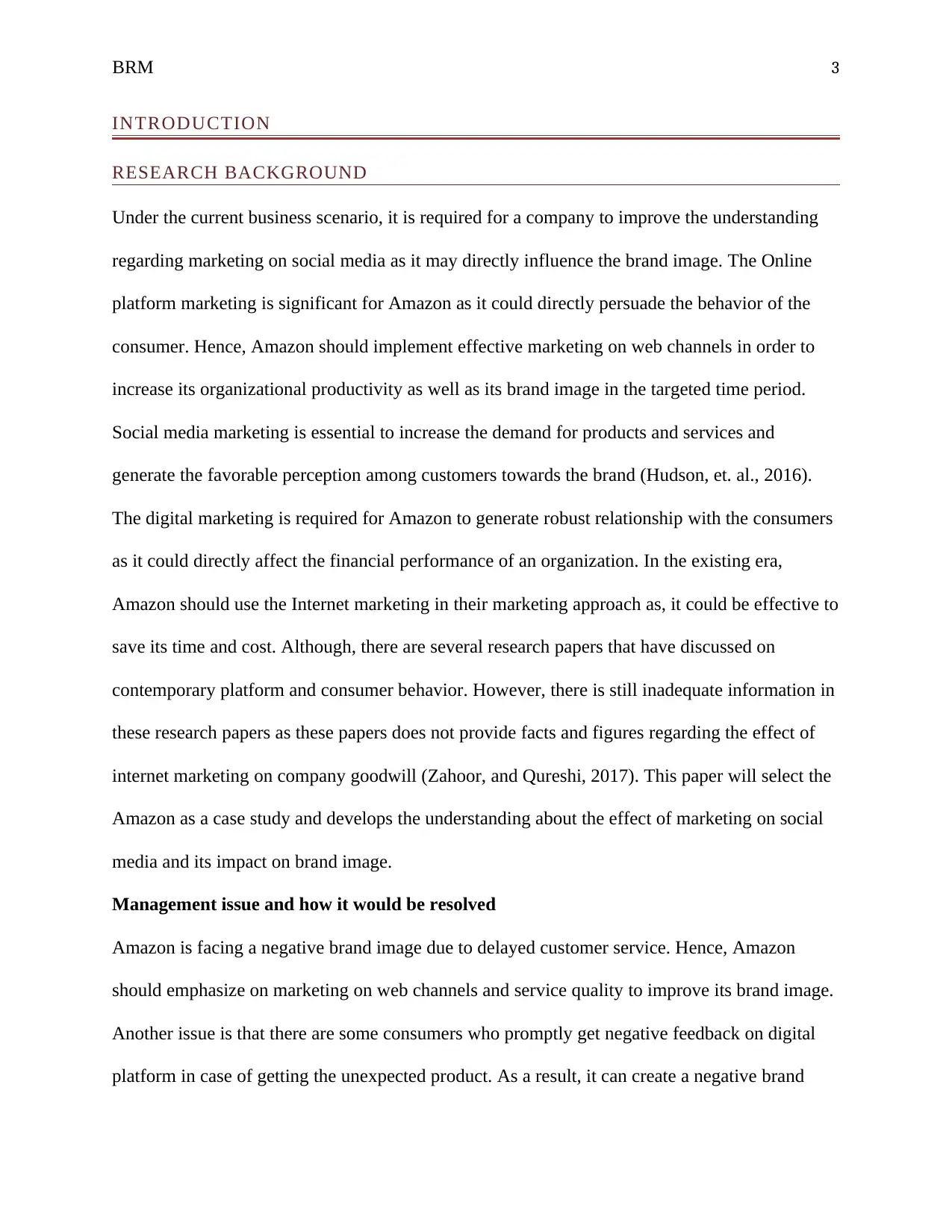
BRM 3
INTRODUCTION
RESEARCH BACKGROUND
Under the current business scenario, it is required for a company to improve the understanding
regarding marketing on social media as it may directly influence the brand image. The Online
platform marketing is significant for Amazon as it could directly persuade the behavior of the
consumer. Hence, Amazon should implement effective marketing on web channels in order to
increase its organizational productivity as well as its brand image in the targeted time period.
Social media marketing is essential to increase the demand for products and services and
generate the favorable perception among customers towards the brand (Hudson, et. al., 2016).
The digital marketing is required for Amazon to generate robust relationship with the consumers
as it could directly affect the financial performance of an organization. In the existing era,
Amazon should use the Internet marketing in their marketing approach as, it could be effective to
save its time and cost. Although, there are several research papers that have discussed on
contemporary platform and consumer behavior. However, there is still inadequate information in
these research papers as these papers does not provide facts and figures regarding the effect of
internet marketing on company goodwill (Zahoor, and Qureshi, 2017). This paper will select the
Amazon as a case study and develops the understanding about the effect of marketing on social
media and its impact on brand image.
Management issue and how it would be resolved
Amazon is facing a negative brand image due to delayed customer service. Hence, Amazon
should emphasize on marketing on web channels and service quality to improve its brand image.
Another issue is that there are some consumers who promptly get negative feedback on digital
platform in case of getting the unexpected product. As a result, it can create a negative brand
INTRODUCTION
RESEARCH BACKGROUND
Under the current business scenario, it is required for a company to improve the understanding
regarding marketing on social media as it may directly influence the brand image. The Online
platform marketing is significant for Amazon as it could directly persuade the behavior of the
consumer. Hence, Amazon should implement effective marketing on web channels in order to
increase its organizational productivity as well as its brand image in the targeted time period.
Social media marketing is essential to increase the demand for products and services and
generate the favorable perception among customers towards the brand (Hudson, et. al., 2016).
The digital marketing is required for Amazon to generate robust relationship with the consumers
as it could directly affect the financial performance of an organization. In the existing era,
Amazon should use the Internet marketing in their marketing approach as, it could be effective to
save its time and cost. Although, there are several research papers that have discussed on
contemporary platform and consumer behavior. However, there is still inadequate information in
these research papers as these papers does not provide facts and figures regarding the effect of
internet marketing on company goodwill (Zahoor, and Qureshi, 2017). This paper will select the
Amazon as a case study and develops the understanding about the effect of marketing on social
media and its impact on brand image.
Management issue and how it would be resolved
Amazon is facing a negative brand image due to delayed customer service. Hence, Amazon
should emphasize on marketing on web channels and service quality to improve its brand image.
Another issue is that there are some consumers who promptly get negative feedback on digital
platform in case of getting the unexpected product. As a result, it can create a negative brand
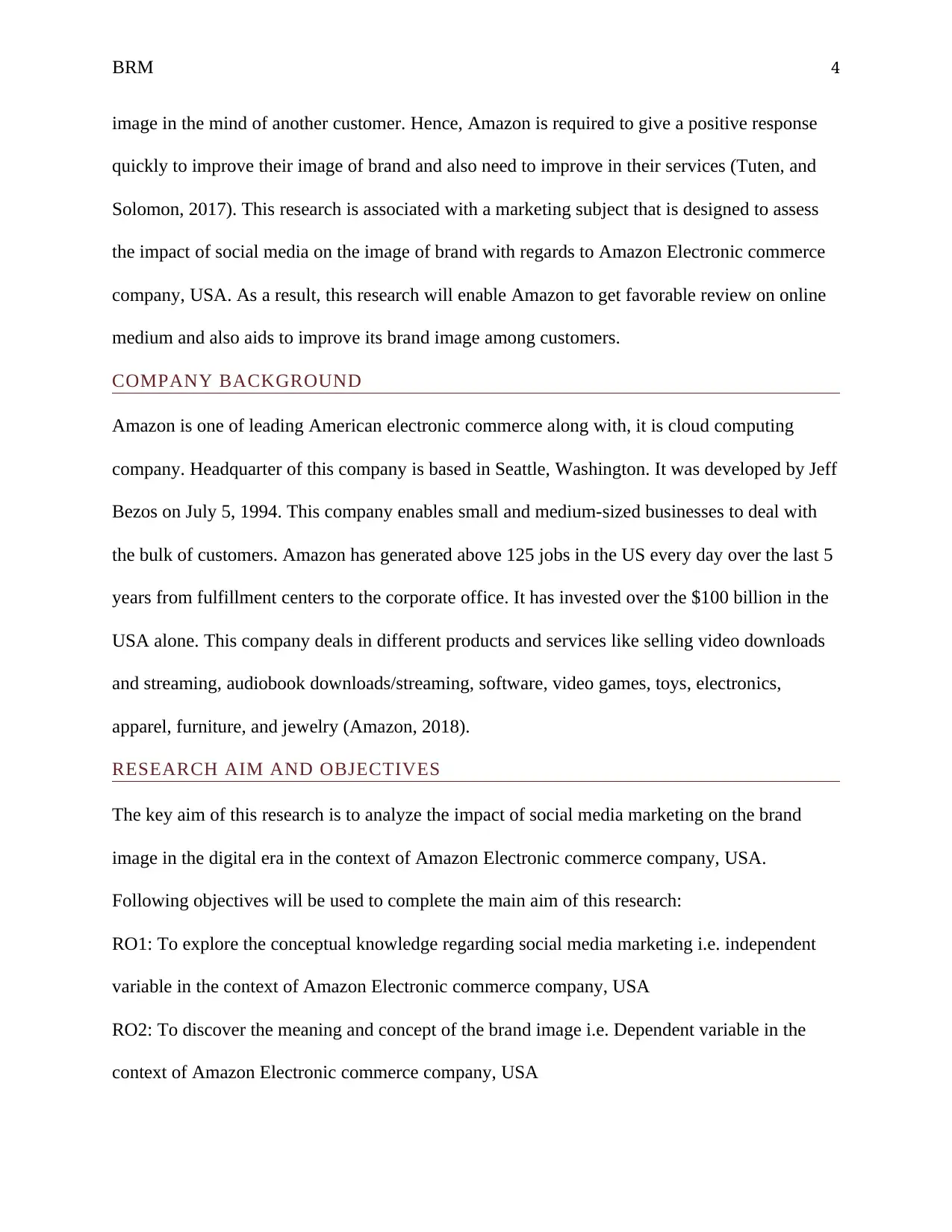
BRM 4
image in the mind of another customer. Hence, Amazon is required to give a positive response
quickly to improve their image of brand and also need to improve in their services (Tuten, and
Solomon, 2017). This research is associated with a marketing subject that is designed to assess
the impact of social media on the image of brand with regards to Amazon Electronic commerce
company, USA. As a result, this research will enable Amazon to get favorable review on online
medium and also aids to improve its brand image among customers.
COMPANY BACKGROUND
Amazon is one of leading American electronic commerce along with, it is cloud computing
company. Headquarter of this company is based in Seattle, Washington. It was developed by Jeff
Bezos on July 5, 1994. This company enables small and medium-sized businesses to deal with
the bulk of customers. Amazon has generated above 125 jobs in the US every day over the last 5
years from fulfillment centers to the corporate office. It has invested over the $100 billion in the
USA alone. This company deals in different products and services like selling video downloads
and streaming, audiobook downloads/streaming, software, video games, toys, electronics,
apparel, furniture, and jewelry (Amazon, 2018).
RESEARCH AIM AND OBJECTIVES
The key aim of this research is to analyze the impact of social media marketing on the brand
image in the digital era in the context of Amazon Electronic commerce company, USA.
Following objectives will be used to complete the main aim of this research:
RO1: To explore the conceptual knowledge regarding social media marketing i.e. independent
variable in the context of Amazon Electronic commerce company, USA
RO2: To discover the meaning and concept of the brand image i.e. Dependent variable in the
context of Amazon Electronic commerce company, USA
image in the mind of another customer. Hence, Amazon is required to give a positive response
quickly to improve their image of brand and also need to improve in their services (Tuten, and
Solomon, 2017). This research is associated with a marketing subject that is designed to assess
the impact of social media on the image of brand with regards to Amazon Electronic commerce
company, USA. As a result, this research will enable Amazon to get favorable review on online
medium and also aids to improve its brand image among customers.
COMPANY BACKGROUND
Amazon is one of leading American electronic commerce along with, it is cloud computing
company. Headquarter of this company is based in Seattle, Washington. It was developed by Jeff
Bezos on July 5, 1994. This company enables small and medium-sized businesses to deal with
the bulk of customers. Amazon has generated above 125 jobs in the US every day over the last 5
years from fulfillment centers to the corporate office. It has invested over the $100 billion in the
USA alone. This company deals in different products and services like selling video downloads
and streaming, audiobook downloads/streaming, software, video games, toys, electronics,
apparel, furniture, and jewelry (Amazon, 2018).
RESEARCH AIM AND OBJECTIVES
The key aim of this research is to analyze the impact of social media marketing on the brand
image in the digital era in the context of Amazon Electronic commerce company, USA.
Following objectives will be used to complete the main aim of this research:
RO1: To explore the conceptual knowledge regarding social media marketing i.e. independent
variable in the context of Amazon Electronic commerce company, USA
RO2: To discover the meaning and concept of the brand image i.e. Dependent variable in the
context of Amazon Electronic commerce company, USA
Secure Best Marks with AI Grader
Need help grading? Try our AI Grader for instant feedback on your assignments.
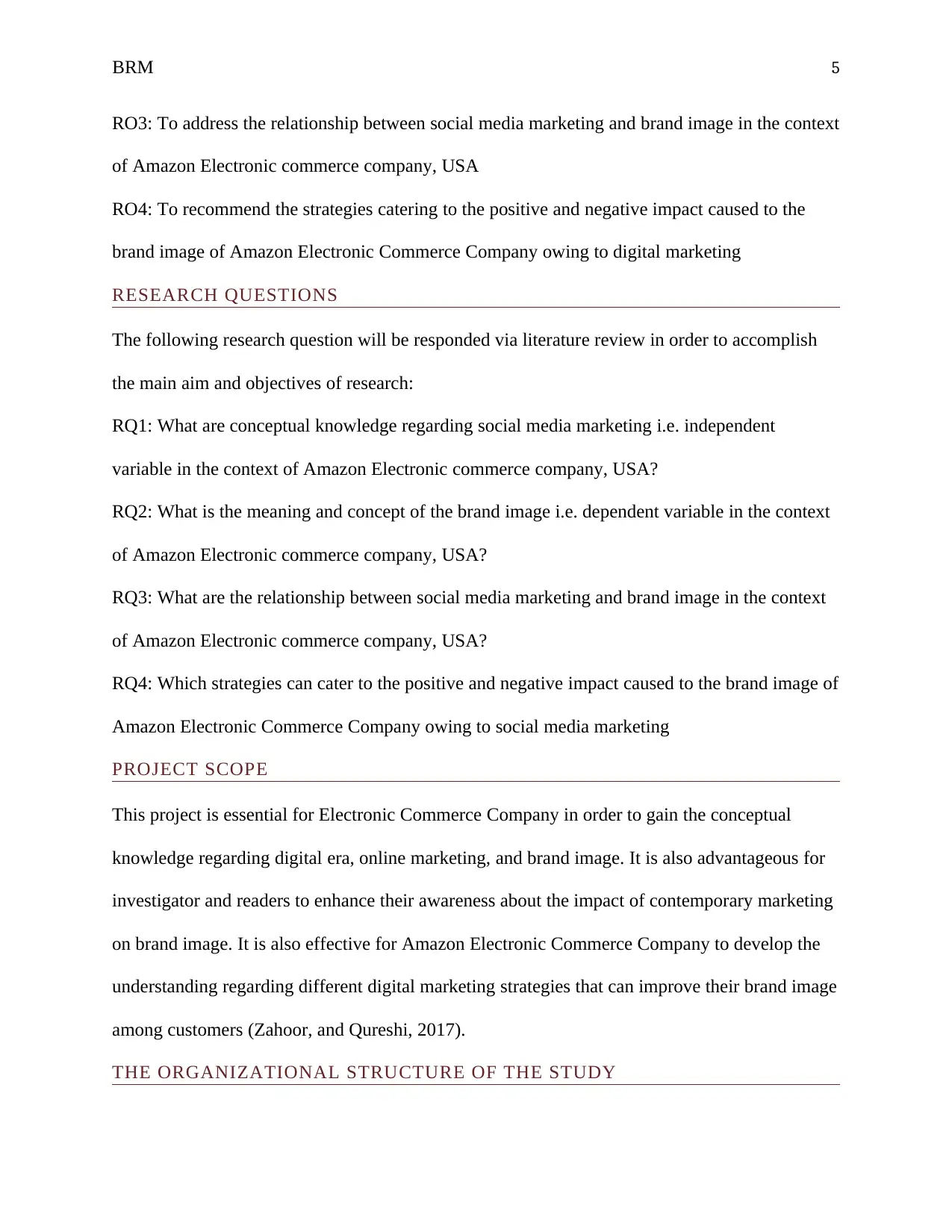
BRM 5
RO3: To address the relationship between social media marketing and brand image in the context
of Amazon Electronic commerce company, USA
RO4: To recommend the strategies catering to the positive and negative impact caused to the
brand image of Amazon Electronic Commerce Company owing to digital marketing
RESEARCH QUESTIONS
The following research question will be responded via literature review in order to accomplish
the main aim and objectives of research:
RQ1: What are conceptual knowledge regarding social media marketing i.e. independent
variable in the context of Amazon Electronic commerce company, USA?
RQ2: What is the meaning and concept of the brand image i.e. dependent variable in the context
of Amazon Electronic commerce company, USA?
RQ3: What are the relationship between social media marketing and brand image in the context
of Amazon Electronic commerce company, USA?
RQ4: Which strategies can cater to the positive and negative impact caused to the brand image of
Amazon Electronic Commerce Company owing to social media marketing
PROJECT SCOPE
This project is essential for Electronic Commerce Company in order to gain the conceptual
knowledge regarding digital era, online marketing, and brand image. It is also advantageous for
investigator and readers to enhance their awareness about the impact of contemporary marketing
on brand image. It is also effective for Amazon Electronic Commerce Company to develop the
understanding regarding different digital marketing strategies that can improve their brand image
among customers (Zahoor, and Qureshi, 2017).
THE ORGANIZATIONAL STRUCTURE OF THE STUDY
RO3: To address the relationship between social media marketing and brand image in the context
of Amazon Electronic commerce company, USA
RO4: To recommend the strategies catering to the positive and negative impact caused to the
brand image of Amazon Electronic Commerce Company owing to digital marketing
RESEARCH QUESTIONS
The following research question will be responded via literature review in order to accomplish
the main aim and objectives of research:
RQ1: What are conceptual knowledge regarding social media marketing i.e. independent
variable in the context of Amazon Electronic commerce company, USA?
RQ2: What is the meaning and concept of the brand image i.e. dependent variable in the context
of Amazon Electronic commerce company, USA?
RQ3: What are the relationship between social media marketing and brand image in the context
of Amazon Electronic commerce company, USA?
RQ4: Which strategies can cater to the positive and negative impact caused to the brand image of
Amazon Electronic Commerce Company owing to social media marketing
PROJECT SCOPE
This project is essential for Electronic Commerce Company in order to gain the conceptual
knowledge regarding digital era, online marketing, and brand image. It is also advantageous for
investigator and readers to enhance their awareness about the impact of contemporary marketing
on brand image. It is also effective for Amazon Electronic Commerce Company to develop the
understanding regarding different digital marketing strategies that can improve their brand image
among customers (Zahoor, and Qureshi, 2017).
THE ORGANIZATIONAL STRUCTURE OF THE STUDY
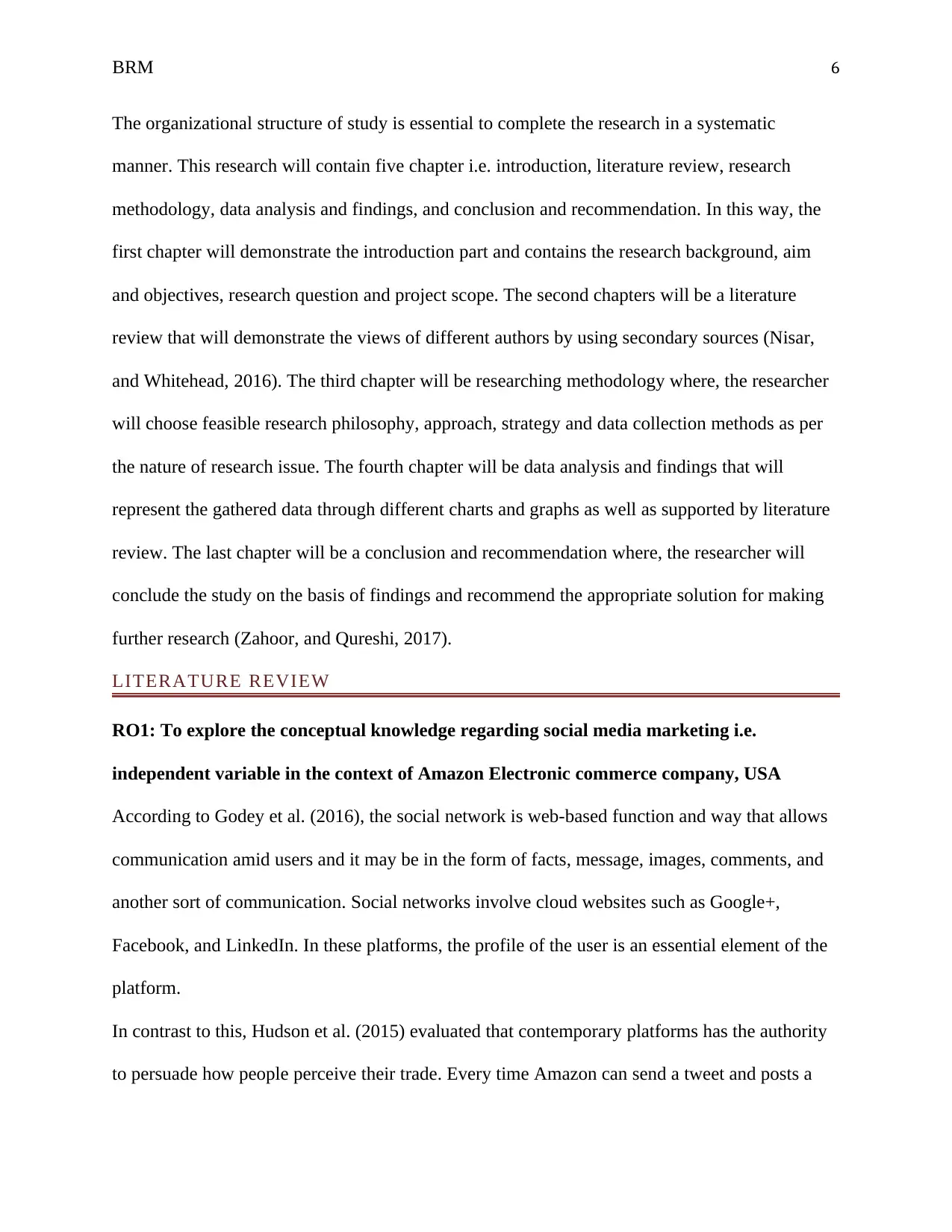
BRM 6
The organizational structure of study is essential to complete the research in a systematic
manner. This research will contain five chapter i.e. introduction, literature review, research
methodology, data analysis and findings, and conclusion and recommendation. In this way, the
first chapter will demonstrate the introduction part and contains the research background, aim
and objectives, research question and project scope. The second chapters will be a literature
review that will demonstrate the views of different authors by using secondary sources (Nisar,
and Whitehead, 2016). The third chapter will be researching methodology where, the researcher
will choose feasible research philosophy, approach, strategy and data collection methods as per
the nature of research issue. The fourth chapter will be data analysis and findings that will
represent the gathered data through different charts and graphs as well as supported by literature
review. The last chapter will be a conclusion and recommendation where, the researcher will
conclude the study on the basis of findings and recommend the appropriate solution for making
further research (Zahoor, and Qureshi, 2017).
LITERATURE REVIEW
RO1: To explore the conceptual knowledge regarding social media marketing i.e.
independent variable in the context of Amazon Electronic commerce company, USA
According to Godey et al. (2016), the social network is web-based function and way that allows
communication amid users and it may be in the form of facts, message, images, comments, and
another sort of communication. Social networks involve cloud websites such as Google+,
Facebook, and LinkedIn. In these platforms, the profile of the user is an essential element of the
platform.
In contrast to this, Hudson et al. (2015) evaluated that contemporary platforms has the authority
to persuade how people perceive their trade. Every time Amazon can send a tweet and posts a
The organizational structure of study is essential to complete the research in a systematic
manner. This research will contain five chapter i.e. introduction, literature review, research
methodology, data analysis and findings, and conclusion and recommendation. In this way, the
first chapter will demonstrate the introduction part and contains the research background, aim
and objectives, research question and project scope. The second chapters will be a literature
review that will demonstrate the views of different authors by using secondary sources (Nisar,
and Whitehead, 2016). The third chapter will be researching methodology where, the researcher
will choose feasible research philosophy, approach, strategy and data collection methods as per
the nature of research issue. The fourth chapter will be data analysis and findings that will
represent the gathered data through different charts and graphs as well as supported by literature
review. The last chapter will be a conclusion and recommendation where, the researcher will
conclude the study on the basis of findings and recommend the appropriate solution for making
further research (Zahoor, and Qureshi, 2017).
LITERATURE REVIEW
RO1: To explore the conceptual knowledge regarding social media marketing i.e.
independent variable in the context of Amazon Electronic commerce company, USA
According to Godey et al. (2016), the social network is web-based function and way that allows
communication amid users and it may be in the form of facts, message, images, comments, and
another sort of communication. Social networks involve cloud websites such as Google+,
Facebook, and LinkedIn. In these platforms, the profile of the user is an essential element of the
platform.
In contrast to this, Hudson et al. (2015) evaluated that contemporary platforms has the authority
to persuade how people perceive their trade. Every time Amazon can send a tweet and posts a
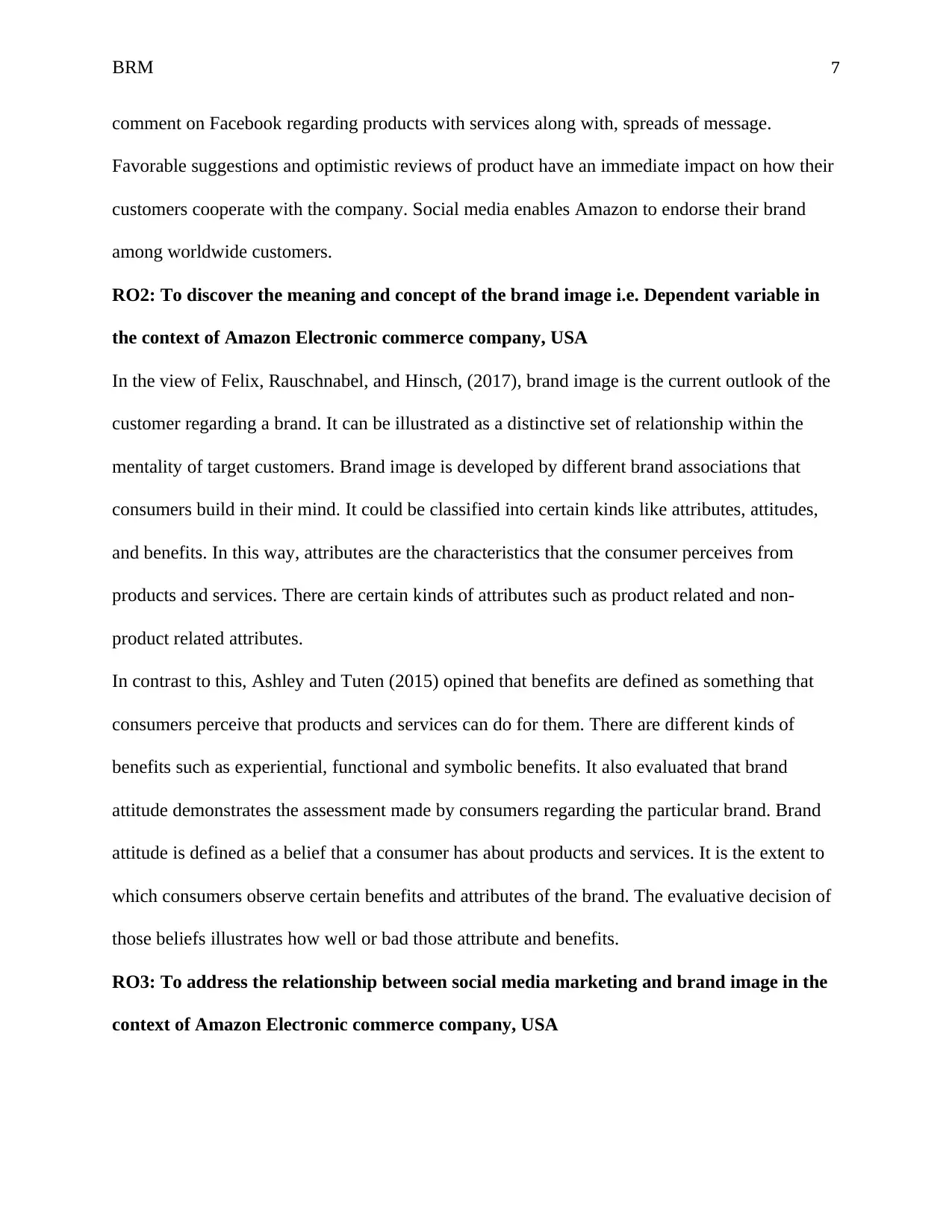
BRM 7
comment on Facebook regarding products with services along with, spreads of message.
Favorable suggestions and optimistic reviews of product have an immediate impact on how their
customers cooperate with the company. Social media enables Amazon to endorse their brand
among worldwide customers.
RO2: To discover the meaning and concept of the brand image i.e. Dependent variable in
the context of Amazon Electronic commerce company, USA
In the view of Felix, Rauschnabel, and Hinsch, (2017), brand image is the current outlook of the
customer regarding a brand. It can be illustrated as a distinctive set of relationship within the
mentality of target customers. Brand image is developed by different brand associations that
consumers build in their mind. It could be classified into certain kinds like attributes, attitudes,
and benefits. In this way, attributes are the characteristics that the consumer perceives from
products and services. There are certain kinds of attributes such as product related and non-
product related attributes.
In contrast to this, Ashley and Tuten (2015) opined that benefits are defined as something that
consumers perceive that products and services can do for them. There are different kinds of
benefits such as experiential, functional and symbolic benefits. It also evaluated that brand
attitude demonstrates the assessment made by consumers regarding the particular brand. Brand
attitude is defined as a belief that a consumer has about products and services. It is the extent to
which consumers observe certain benefits and attributes of the brand. The evaluative decision of
those beliefs illustrates how well or bad those attribute and benefits.
RO3: To address the relationship between social media marketing and brand image in the
context of Amazon Electronic commerce company, USA
comment on Facebook regarding products with services along with, spreads of message.
Favorable suggestions and optimistic reviews of product have an immediate impact on how their
customers cooperate with the company. Social media enables Amazon to endorse their brand
among worldwide customers.
RO2: To discover the meaning and concept of the brand image i.e. Dependent variable in
the context of Amazon Electronic commerce company, USA
In the view of Felix, Rauschnabel, and Hinsch, (2017), brand image is the current outlook of the
customer regarding a brand. It can be illustrated as a distinctive set of relationship within the
mentality of target customers. Brand image is developed by different brand associations that
consumers build in their mind. It could be classified into certain kinds like attributes, attitudes,
and benefits. In this way, attributes are the characteristics that the consumer perceives from
products and services. There are certain kinds of attributes such as product related and non-
product related attributes.
In contrast to this, Ashley and Tuten (2015) opined that benefits are defined as something that
consumers perceive that products and services can do for them. There are different kinds of
benefits such as experiential, functional and symbolic benefits. It also evaluated that brand
attitude demonstrates the assessment made by consumers regarding the particular brand. Brand
attitude is defined as a belief that a consumer has about products and services. It is the extent to
which consumers observe certain benefits and attributes of the brand. The evaluative decision of
those beliefs illustrates how well or bad those attribute and benefits.
RO3: To address the relationship between social media marketing and brand image in the
context of Amazon Electronic commerce company, USA
Paraphrase This Document
Need a fresh take? Get an instant paraphrase of this document with our AI Paraphraser
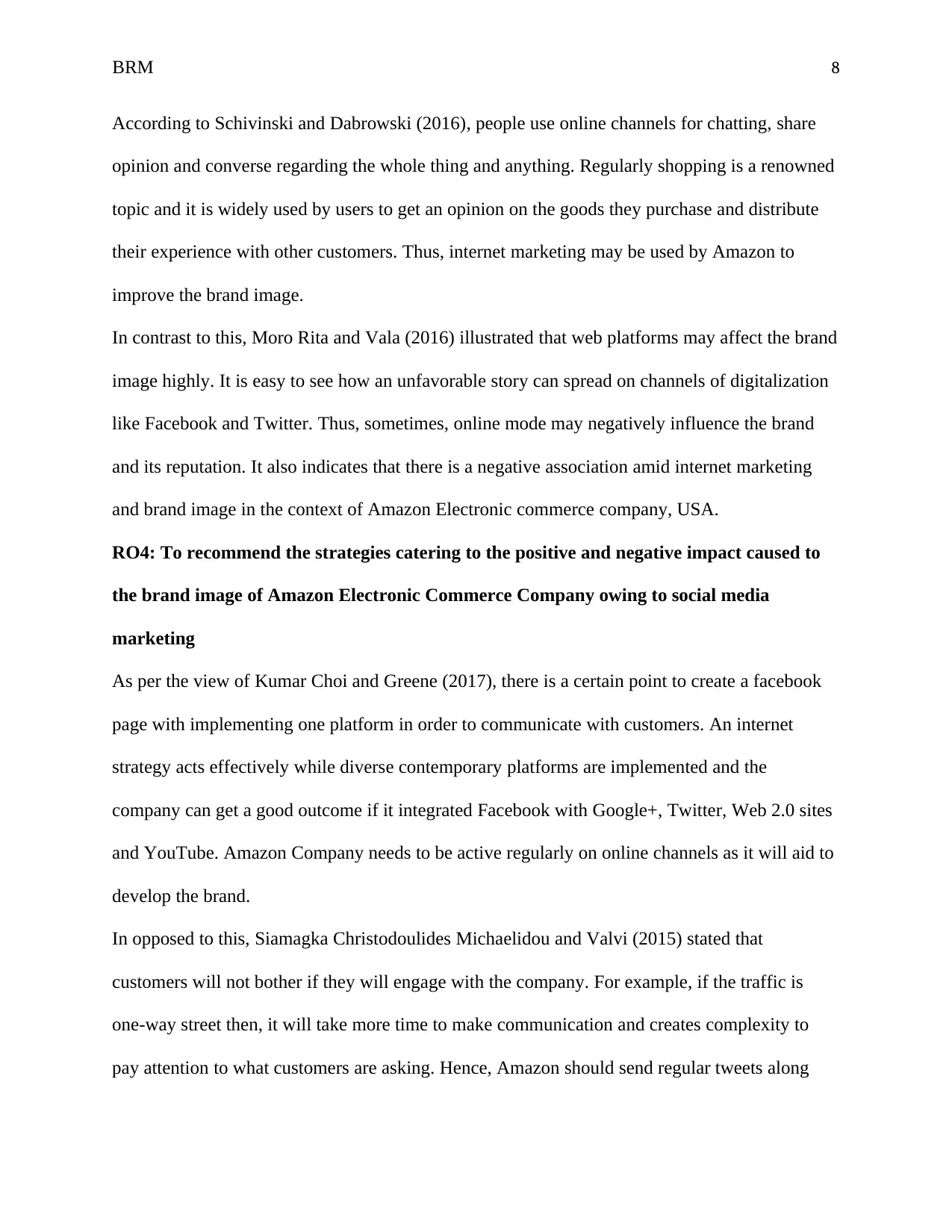
BRM 8
According to Schivinski and Dabrowski (2016), people use online channels for chatting, share
opinion and converse regarding the whole thing and anything. Regularly shopping is a renowned
topic and it is widely used by users to get an opinion on the goods they purchase and distribute
their experience with other customers. Thus, internet marketing may be used by Amazon to
improve the brand image.
In contrast to this, Moro Rita and Vala (2016) illustrated that web platforms may affect the brand
image highly. It is easy to see how an unfavorable story can spread on channels of digitalization
like Facebook and Twitter. Thus, sometimes, online mode may negatively influence the brand
and its reputation. It also indicates that there is a negative association amid internet marketing
and brand image in the context of Amazon Electronic commerce company, USA.
RO4: To recommend the strategies catering to the positive and negative impact caused to
the brand image of Amazon Electronic Commerce Company owing to social media
marketing
As per the view of Kumar Choi and Greene (2017), there is a certain point to create a facebook
page with implementing one platform in order to communicate with customers. An internet
strategy acts effectively while diverse contemporary platforms are implemented and the
company can get a good outcome if it integrated Facebook with Google+, Twitter, Web 2.0 sites
and YouTube. Amazon Company needs to be active regularly on online channels as it will aid to
develop the brand.
In opposed to this, Siamagka Christodoulides Michaelidou and Valvi (2015) stated that
customers will not bother if they will engage with the company. For example, if the traffic is
one-way street then, it will take more time to make communication and creates complexity to
pay attention to what customers are asking. Hence, Amazon should send regular tweets along
According to Schivinski and Dabrowski (2016), people use online channels for chatting, share
opinion and converse regarding the whole thing and anything. Regularly shopping is a renowned
topic and it is widely used by users to get an opinion on the goods they purchase and distribute
their experience with other customers. Thus, internet marketing may be used by Amazon to
improve the brand image.
In contrast to this, Moro Rita and Vala (2016) illustrated that web platforms may affect the brand
image highly. It is easy to see how an unfavorable story can spread on channels of digitalization
like Facebook and Twitter. Thus, sometimes, online mode may negatively influence the brand
and its reputation. It also indicates that there is a negative association amid internet marketing
and brand image in the context of Amazon Electronic commerce company, USA.
RO4: To recommend the strategies catering to the positive and negative impact caused to
the brand image of Amazon Electronic Commerce Company owing to social media
marketing
As per the view of Kumar Choi and Greene (2017), there is a certain point to create a facebook
page with implementing one platform in order to communicate with customers. An internet
strategy acts effectively while diverse contemporary platforms are implemented and the
company can get a good outcome if it integrated Facebook with Google+, Twitter, Web 2.0 sites
and YouTube. Amazon Company needs to be active regularly on online channels as it will aid to
develop the brand.
In opposed to this, Siamagka Christodoulides Michaelidou and Valvi (2015) stated that
customers will not bother if they will engage with the company. For example, if the traffic is
one-way street then, it will take more time to make communication and creates complexity to
pay attention to what customers are asking. Hence, Amazon should send regular tweets along
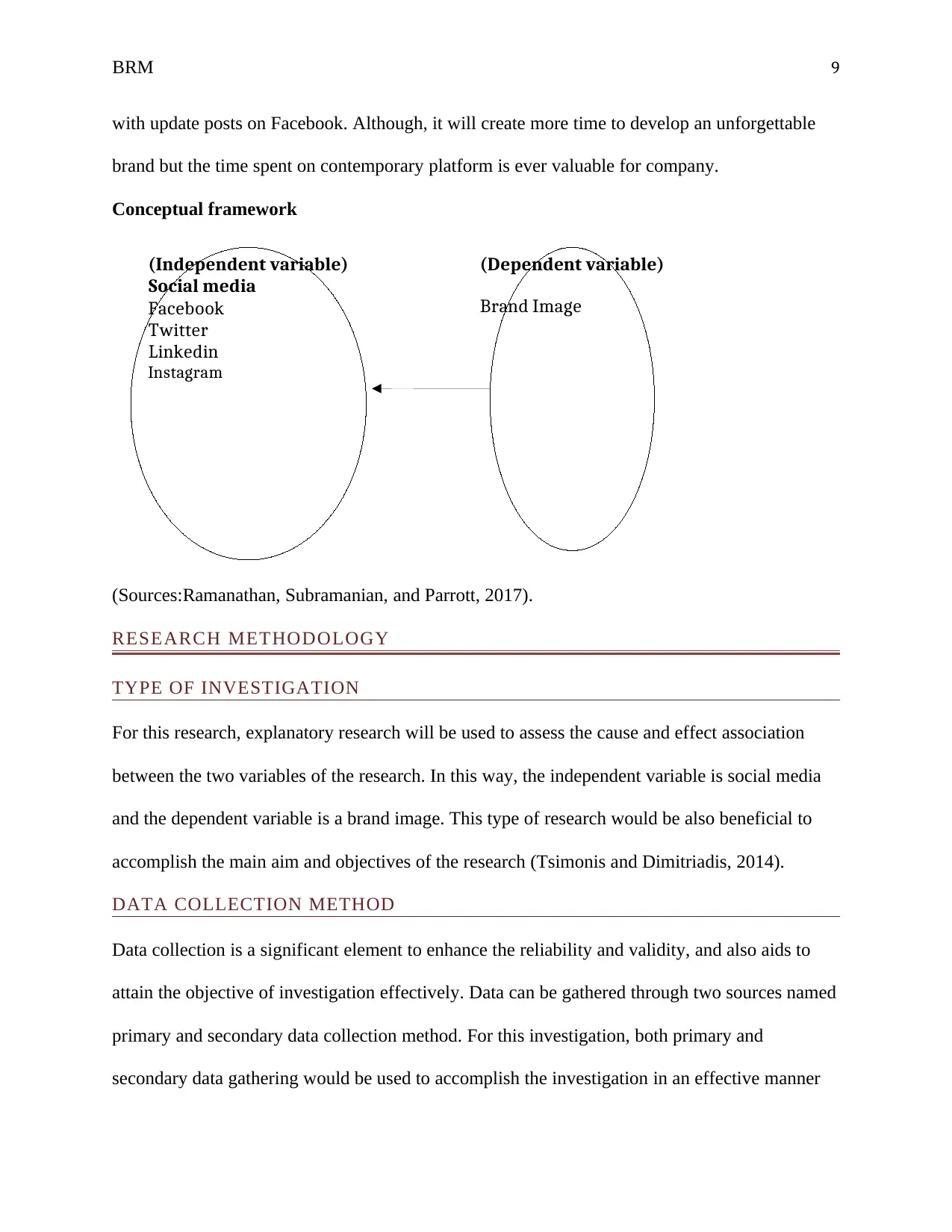
(Independent variable)
Social media
Facebook
Twitter
Linkedin
Instagram
(Dependent variable)
Brand Image
BRM 9
with update posts on Facebook. Although, it will create more time to develop an unforgettable
brand but the time spent on contemporary platform is ever valuable for company.
Conceptual framework
(Sources:Ramanathan, Subramanian, and Parrott, 2017).
RESEARCH METHODOLOGY
TYPE OF INVESTIGATION
For this research, explanatory research will be used to assess the cause and effect association
between the two variables of the research. In this way, the independent variable is social media
and the dependent variable is a brand image. This type of research would be also beneficial to
accomplish the main aim and objectives of the research (Tsimonis and Dimitriadis, 2014).
DATA COLLECTION METHOD
Data collection is a significant element to enhance the reliability and validity, and also aids to
attain the objective of investigation effectively. Data can be gathered through two sources named
primary and secondary data collection method. For this investigation, both primary and
secondary data gathering would be used to accomplish the investigation in an effective manner
Social media
(Dependent variable)
Brand Image
BRM 9
with update posts on Facebook. Although, it will create more time to develop an unforgettable
brand but the time spent on contemporary platform is ever valuable for company.
Conceptual framework
(Sources:Ramanathan, Subramanian, and Parrott, 2017).
RESEARCH METHODOLOGY
TYPE OF INVESTIGATION
For this research, explanatory research will be used to assess the cause and effect association
between the two variables of the research. In this way, the independent variable is social media
and the dependent variable is a brand image. This type of research would be also beneficial to
accomplish the main aim and objectives of the research (Tsimonis and Dimitriadis, 2014).
DATA COLLECTION METHOD
Data collection is a significant element to enhance the reliability and validity, and also aids to
attain the objective of investigation effectively. Data can be gathered through two sources named
primary and secondary data collection method. For this investigation, both primary and
secondary data gathering would be used to accomplish the investigation in an effective manner

BRM 10
(Cawsey, and Rowley, 2016). Primary data would be gathered via survey through questionnaire
and interview to get the fresh information regarding research concern. Secondary information
would be gathered via textbooks, academic publication, online websites, journal articles, and
company websites. It would be selected to get authentic information regarding research concern
with minimum time (Yazdanparast, Joseph, and Muniz, 2016).
SAMPLING METHOD
For this research, a simple probability random sampling method will be used to select the
participants from a large number of the population on a random basis. It would be selected to
decline the chances of biases from the investigation. Furthermore, 50 consumers will be selected
as a sample size that uses Amazon by influencing the social media. These customers will be
selected from the different geographical location (Bianchi, and Andrews, 2015).
ACCESSIBILITY ISSUES
In this research, an investigator will face different accessibility issues during gathering the data.
It is stated that gathering of primary data will take more time that creates complexity to access
the reliable data and attain the objective in the targeted time period. Furthermore, gathering
secondary data will take more cost of the researcher as it creates difficulties to access the depth
information regarding research issue. Limited resources are another accessibility issue that may
create complexity in gathering feasible data (Wang, and Kim, 2017). Along with this, a lack of
interest among research participants also creates an accessibility issue to get reliable data from
them.
For avoiding such concern, the researcher should manage the time by developing the Gantt chart
before starting the project. The researcher should manage the budget to access the secondary
data. They should also manage optimum utilization of resources to get feasible data. Moreover,
(Cawsey, and Rowley, 2016). Primary data would be gathered via survey through questionnaire
and interview to get the fresh information regarding research concern. Secondary information
would be gathered via textbooks, academic publication, online websites, journal articles, and
company websites. It would be selected to get authentic information regarding research concern
with minimum time (Yazdanparast, Joseph, and Muniz, 2016).
SAMPLING METHOD
For this research, a simple probability random sampling method will be used to select the
participants from a large number of the population on a random basis. It would be selected to
decline the chances of biases from the investigation. Furthermore, 50 consumers will be selected
as a sample size that uses Amazon by influencing the social media. These customers will be
selected from the different geographical location (Bianchi, and Andrews, 2015).
ACCESSIBILITY ISSUES
In this research, an investigator will face different accessibility issues during gathering the data.
It is stated that gathering of primary data will take more time that creates complexity to access
the reliable data and attain the objective in the targeted time period. Furthermore, gathering
secondary data will take more cost of the researcher as it creates difficulties to access the depth
information regarding research issue. Limited resources are another accessibility issue that may
create complexity in gathering feasible data (Wang, and Kim, 2017). Along with this, a lack of
interest among research participants also creates an accessibility issue to get reliable data from
them.
For avoiding such concern, the researcher should manage the time by developing the Gantt chart
before starting the project. The researcher should manage the budget to access the secondary
data. They should also manage optimum utilization of resources to get feasible data. Moreover,
Secure Best Marks with AI Grader
Need help grading? Try our AI Grader for instant feedback on your assignments.
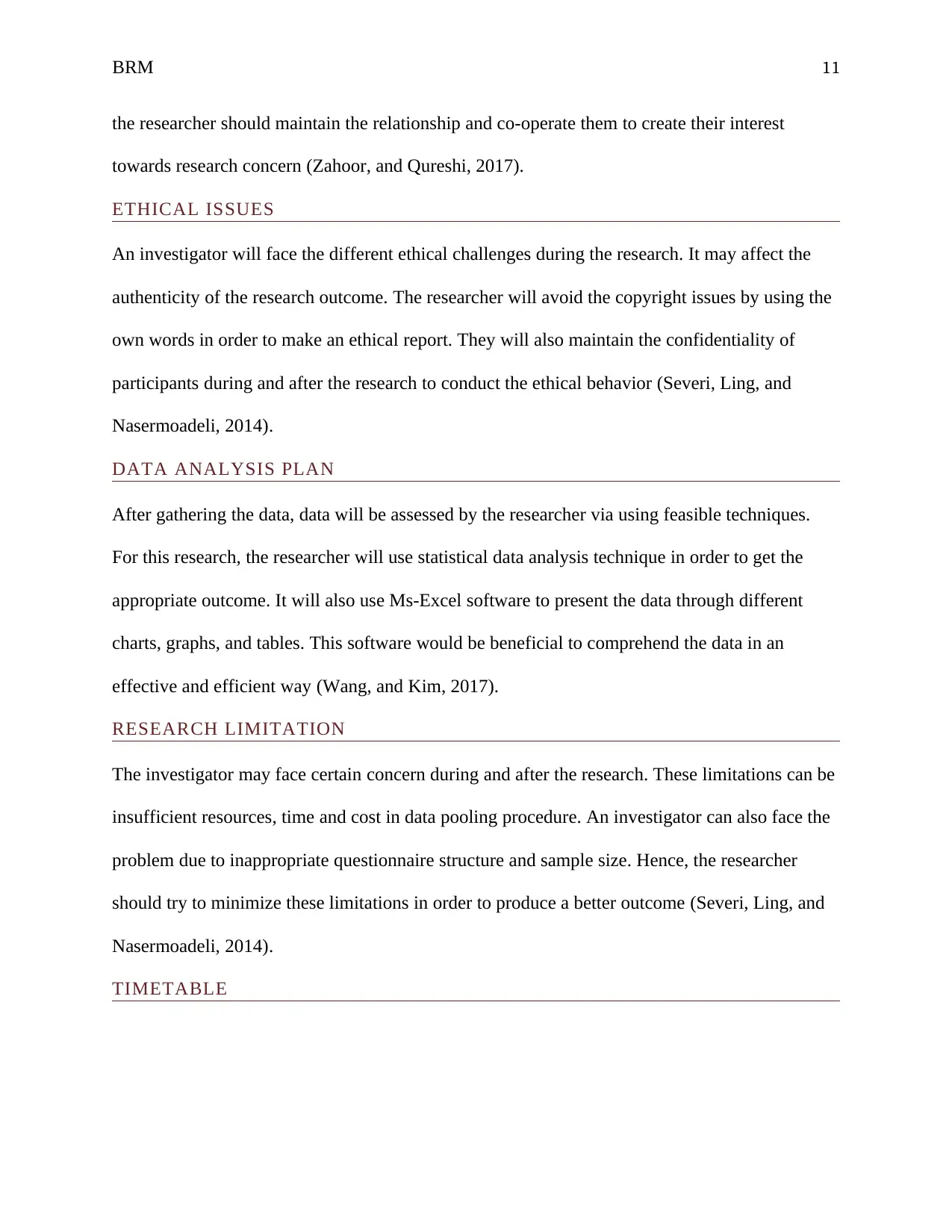
BRM 11
the researcher should maintain the relationship and co-operate them to create their interest
towards research concern (Zahoor, and Qureshi, 2017).
ETHICAL ISSUES
An investigator will face the different ethical challenges during the research. It may affect the
authenticity of the research outcome. The researcher will avoid the copyright issues by using the
own words in order to make an ethical report. They will also maintain the confidentiality of
participants during and after the research to conduct the ethical behavior (Severi, Ling, and
Nasermoadeli, 2014).
DATA ANALYSIS PLAN
After gathering the data, data will be assessed by the researcher via using feasible techniques.
For this research, the researcher will use statistical data analysis technique in order to get the
appropriate outcome. It will also use Ms-Excel software to present the data through different
charts, graphs, and tables. This software would be beneficial to comprehend the data in an
effective and efficient way (Wang, and Kim, 2017).
RESEARCH LIMITATION
The investigator may face certain concern during and after the research. These limitations can be
insufficient resources, time and cost in data pooling procedure. An investigator can also face the
problem due to inappropriate questionnaire structure and sample size. Hence, the researcher
should try to minimize these limitations in order to produce a better outcome (Severi, Ling, and
Nasermoadeli, 2014).
TIMETABLE
the researcher should maintain the relationship and co-operate them to create their interest
towards research concern (Zahoor, and Qureshi, 2017).
ETHICAL ISSUES
An investigator will face the different ethical challenges during the research. It may affect the
authenticity of the research outcome. The researcher will avoid the copyright issues by using the
own words in order to make an ethical report. They will also maintain the confidentiality of
participants during and after the research to conduct the ethical behavior (Severi, Ling, and
Nasermoadeli, 2014).
DATA ANALYSIS PLAN
After gathering the data, data will be assessed by the researcher via using feasible techniques.
For this research, the researcher will use statistical data analysis technique in order to get the
appropriate outcome. It will also use Ms-Excel software to present the data through different
charts, graphs, and tables. This software would be beneficial to comprehend the data in an
effective and efficient way (Wang, and Kim, 2017).
RESEARCH LIMITATION
The investigator may face certain concern during and after the research. These limitations can be
insufficient resources, time and cost in data pooling procedure. An investigator can also face the
problem due to inappropriate questionnaire structure and sample size. Hence, the researcher
should try to minimize these limitations in order to produce a better outcome (Severi, Ling, and
Nasermoadeli, 2014).
TIMETABLE
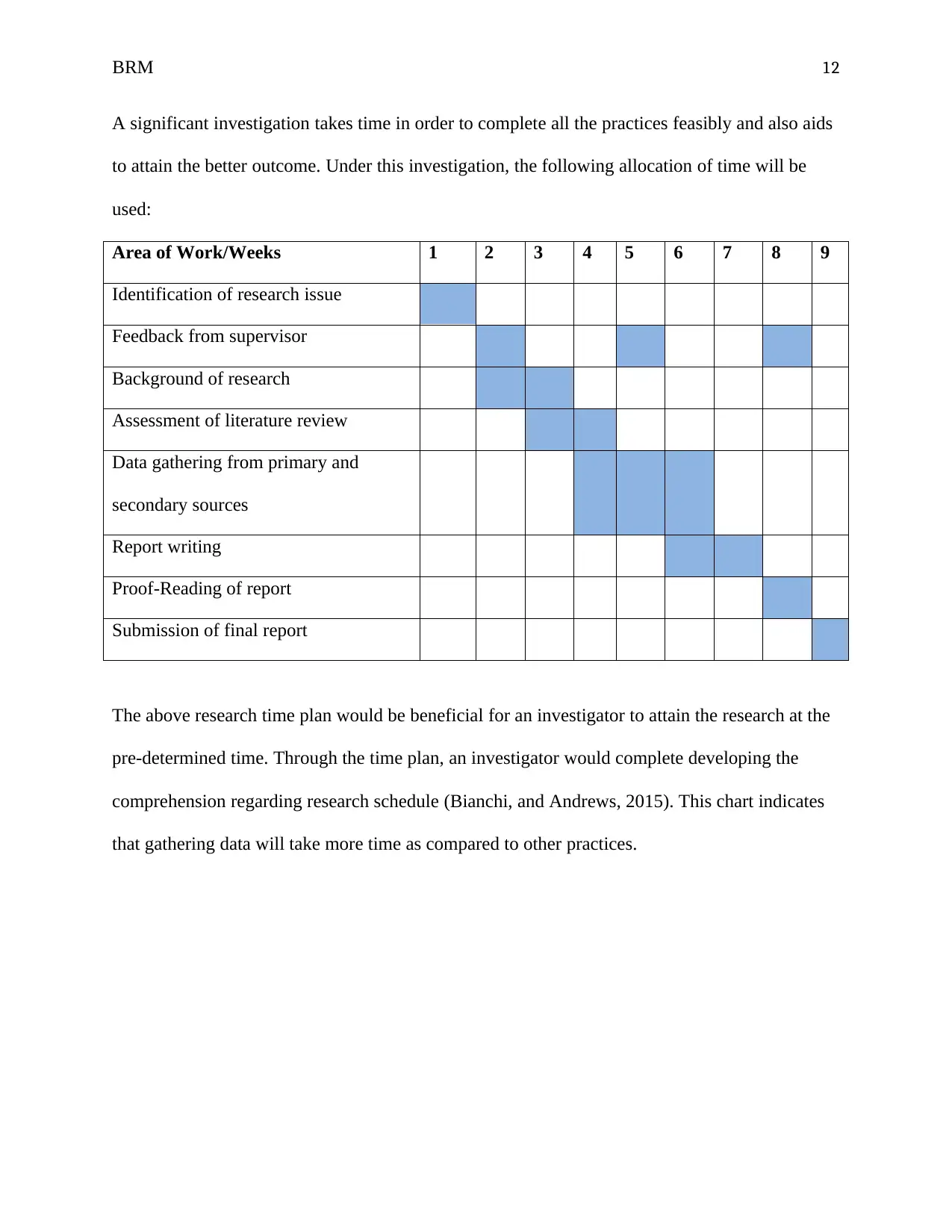
BRM 12
A significant investigation takes time in order to complete all the practices feasibly and also aids
to attain the better outcome. Under this investigation, the following allocation of time will be
used:
Area of Work/Weeks 1 2 3 4 5 6 7 8 9
Identification of research issue
Feedback from supervisor
Background of research
Assessment of literature review
Data gathering from primary and
secondary sources
Report writing
Proof-Reading of report
Submission of final report
The above research time plan would be beneficial for an investigator to attain the research at the
pre-determined time. Through the time plan, an investigator would complete developing the
comprehension regarding research schedule (Bianchi, and Andrews, 2015). This chart indicates
that gathering data will take more time as compared to other practices.
A significant investigation takes time in order to complete all the practices feasibly and also aids
to attain the better outcome. Under this investigation, the following allocation of time will be
used:
Area of Work/Weeks 1 2 3 4 5 6 7 8 9
Identification of research issue
Feedback from supervisor
Background of research
Assessment of literature review
Data gathering from primary and
secondary sources
Report writing
Proof-Reading of report
Submission of final report
The above research time plan would be beneficial for an investigator to attain the research at the
pre-determined time. Through the time plan, an investigator would complete developing the
comprehension regarding research schedule (Bianchi, and Andrews, 2015). This chart indicates
that gathering data will take more time as compared to other practices.
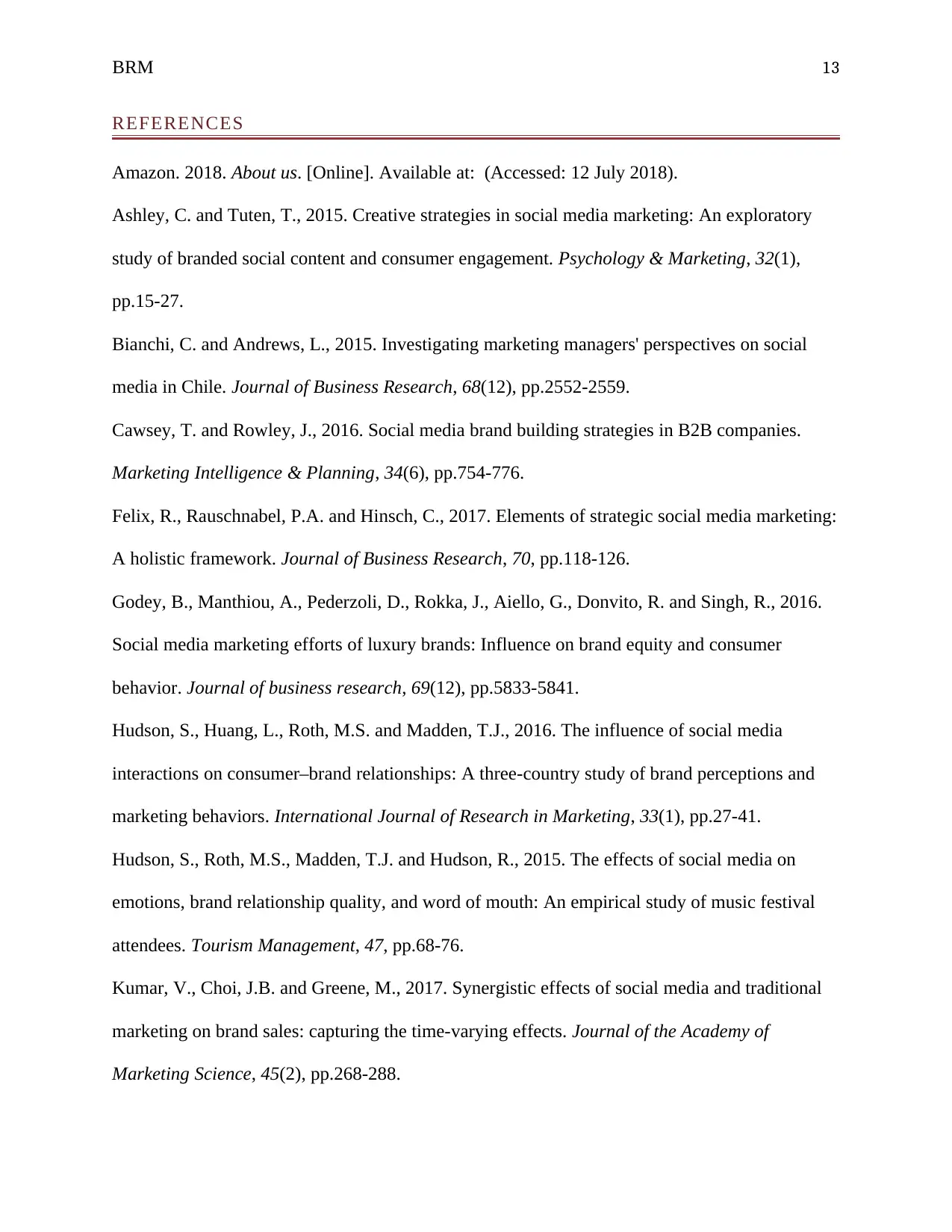
BRM 13
REFERENCES
Amazon. 2018. About us. [Online]. Available at: (Accessed: 12 July 2018).
Ashley, C. and Tuten, T., 2015. Creative strategies in social media marketing: An exploratory
study of branded social content and consumer engagement. Psychology & Marketing, 32(1),
pp.15-27.
Bianchi, C. and Andrews, L., 2015. Investigating marketing managers' perspectives on social
media in Chile. Journal of Business Research, 68(12), pp.2552-2559.
Cawsey, T. and Rowley, J., 2016. Social media brand building strategies in B2B companies.
Marketing Intelligence & Planning, 34(6), pp.754-776.
Felix, R., Rauschnabel, P.A. and Hinsch, C., 2017. Elements of strategic social media marketing:
A holistic framework. Journal of Business Research, 70, pp.118-126.
Godey, B., Manthiou, A., Pederzoli, D., Rokka, J., Aiello, G., Donvito, R. and Singh, R., 2016.
Social media marketing efforts of luxury brands: Influence on brand equity and consumer
behavior. Journal of business research, 69(12), pp.5833-5841.
Hudson, S., Huang, L., Roth, M.S. and Madden, T.J., 2016. The influence of social media
interactions on consumer–brand relationships: A three-country study of brand perceptions and
marketing behaviors. International Journal of Research in Marketing, 33(1), pp.27-41.
Hudson, S., Roth, M.S., Madden, T.J. and Hudson, R., 2015. The effects of social media on
emotions, brand relationship quality, and word of mouth: An empirical study of music festival
attendees. Tourism Management, 47, pp.68-76.
Kumar, V., Choi, J.B. and Greene, M., 2017. Synergistic effects of social media and traditional
marketing on brand sales: capturing the time-varying effects. Journal of the Academy of
Marketing Science, 45(2), pp.268-288.
REFERENCES
Amazon. 2018. About us. [Online]. Available at: (Accessed: 12 July 2018).
Ashley, C. and Tuten, T., 2015. Creative strategies in social media marketing: An exploratory
study of branded social content and consumer engagement. Psychology & Marketing, 32(1),
pp.15-27.
Bianchi, C. and Andrews, L., 2015. Investigating marketing managers' perspectives on social
media in Chile. Journal of Business Research, 68(12), pp.2552-2559.
Cawsey, T. and Rowley, J., 2016. Social media brand building strategies in B2B companies.
Marketing Intelligence & Planning, 34(6), pp.754-776.
Felix, R., Rauschnabel, P.A. and Hinsch, C., 2017. Elements of strategic social media marketing:
A holistic framework. Journal of Business Research, 70, pp.118-126.
Godey, B., Manthiou, A., Pederzoli, D., Rokka, J., Aiello, G., Donvito, R. and Singh, R., 2016.
Social media marketing efforts of luxury brands: Influence on brand equity and consumer
behavior. Journal of business research, 69(12), pp.5833-5841.
Hudson, S., Huang, L., Roth, M.S. and Madden, T.J., 2016. The influence of social media
interactions on consumer–brand relationships: A three-country study of brand perceptions and
marketing behaviors. International Journal of Research in Marketing, 33(1), pp.27-41.
Hudson, S., Roth, M.S., Madden, T.J. and Hudson, R., 2015. The effects of social media on
emotions, brand relationship quality, and word of mouth: An empirical study of music festival
attendees. Tourism Management, 47, pp.68-76.
Kumar, V., Choi, J.B. and Greene, M., 2017. Synergistic effects of social media and traditional
marketing on brand sales: capturing the time-varying effects. Journal of the Academy of
Marketing Science, 45(2), pp.268-288.
Paraphrase This Document
Need a fresh take? Get an instant paraphrase of this document with our AI Paraphraser
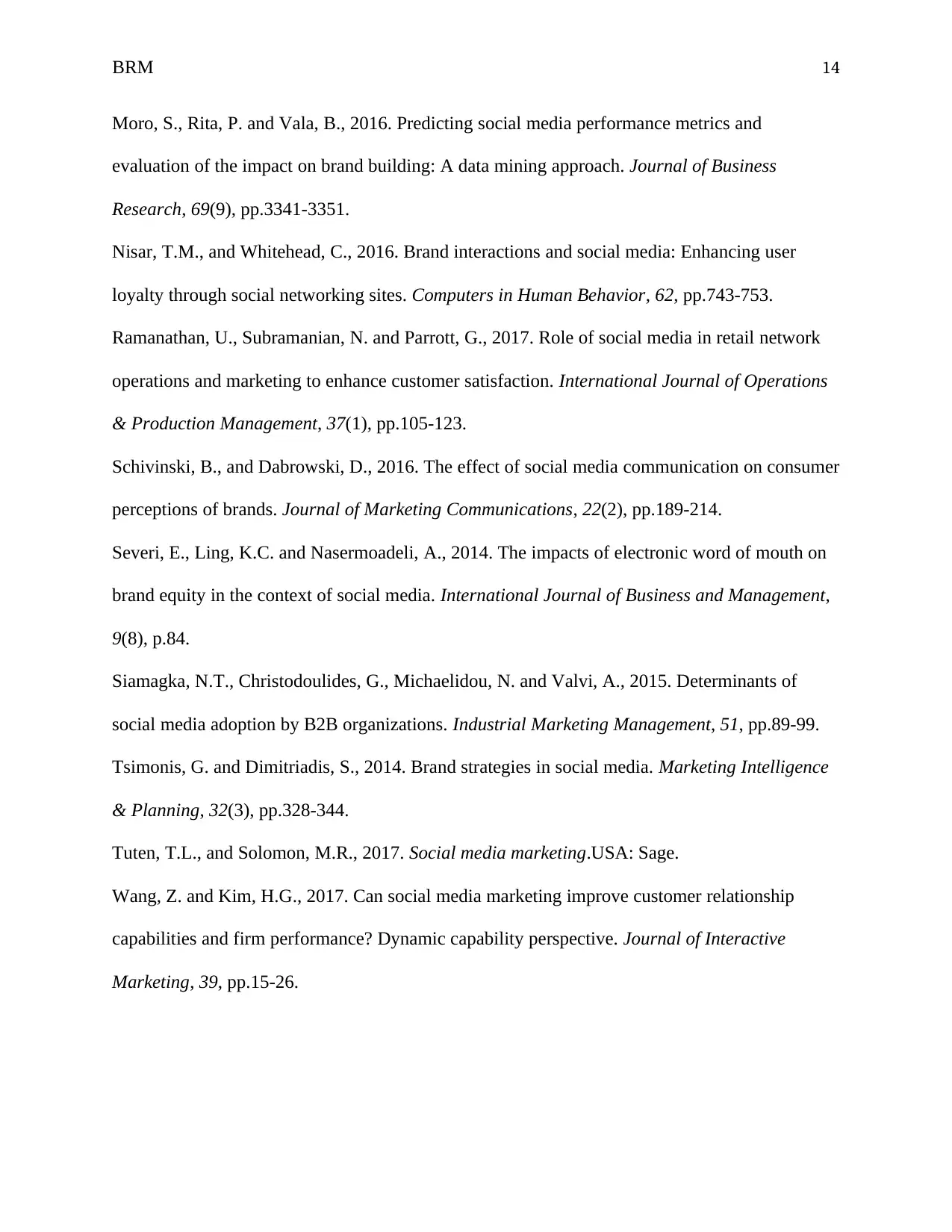
BRM 14
Moro, S., Rita, P. and Vala, B., 2016. Predicting social media performance metrics and
evaluation of the impact on brand building: A data mining approach. Journal of Business
Research, 69(9), pp.3341-3351.
Nisar, T.M., and Whitehead, C., 2016. Brand interactions and social media: Enhancing user
loyalty through social networking sites. Computers in Human Behavior, 62, pp.743-753.
Ramanathan, U., Subramanian, N. and Parrott, G., 2017. Role of social media in retail network
operations and marketing to enhance customer satisfaction. International Journal of Operations
& Production Management, 37(1), pp.105-123.
Schivinski, B., and Dabrowski, D., 2016. The effect of social media communication on consumer
perceptions of brands. Journal of Marketing Communications, 22(2), pp.189-214.
Severi, E., Ling, K.C. and Nasermoadeli, A., 2014. The impacts of electronic word of mouth on
brand equity in the context of social media. International Journal of Business and Management,
9(8), p.84.
Siamagka, N.T., Christodoulides, G., Michaelidou, N. and Valvi, A., 2015. Determinants of
social media adoption by B2B organizations. Industrial Marketing Management, 51, pp.89-99.
Tsimonis, G. and Dimitriadis, S., 2014. Brand strategies in social media. Marketing Intelligence
& Planning, 32(3), pp.328-344.
Tuten, T.L., and Solomon, M.R., 2017. Social media marketing.USA: Sage.
Wang, Z. and Kim, H.G., 2017. Can social media marketing improve customer relationship
capabilities and firm performance? Dynamic capability perspective. Journal of Interactive
Marketing, 39, pp.15-26.
Moro, S., Rita, P. and Vala, B., 2016. Predicting social media performance metrics and
evaluation of the impact on brand building: A data mining approach. Journal of Business
Research, 69(9), pp.3341-3351.
Nisar, T.M., and Whitehead, C., 2016. Brand interactions and social media: Enhancing user
loyalty through social networking sites. Computers in Human Behavior, 62, pp.743-753.
Ramanathan, U., Subramanian, N. and Parrott, G., 2017. Role of social media in retail network
operations and marketing to enhance customer satisfaction. International Journal of Operations
& Production Management, 37(1), pp.105-123.
Schivinski, B., and Dabrowski, D., 2016. The effect of social media communication on consumer
perceptions of brands. Journal of Marketing Communications, 22(2), pp.189-214.
Severi, E., Ling, K.C. and Nasermoadeli, A., 2014. The impacts of electronic word of mouth on
brand equity in the context of social media. International Journal of Business and Management,
9(8), p.84.
Siamagka, N.T., Christodoulides, G., Michaelidou, N. and Valvi, A., 2015. Determinants of
social media adoption by B2B organizations. Industrial Marketing Management, 51, pp.89-99.
Tsimonis, G. and Dimitriadis, S., 2014. Brand strategies in social media. Marketing Intelligence
& Planning, 32(3), pp.328-344.
Tuten, T.L., and Solomon, M.R., 2017. Social media marketing.USA: Sage.
Wang, Z. and Kim, H.G., 2017. Can social media marketing improve customer relationship
capabilities and firm performance? Dynamic capability perspective. Journal of Interactive
Marketing, 39, pp.15-26.
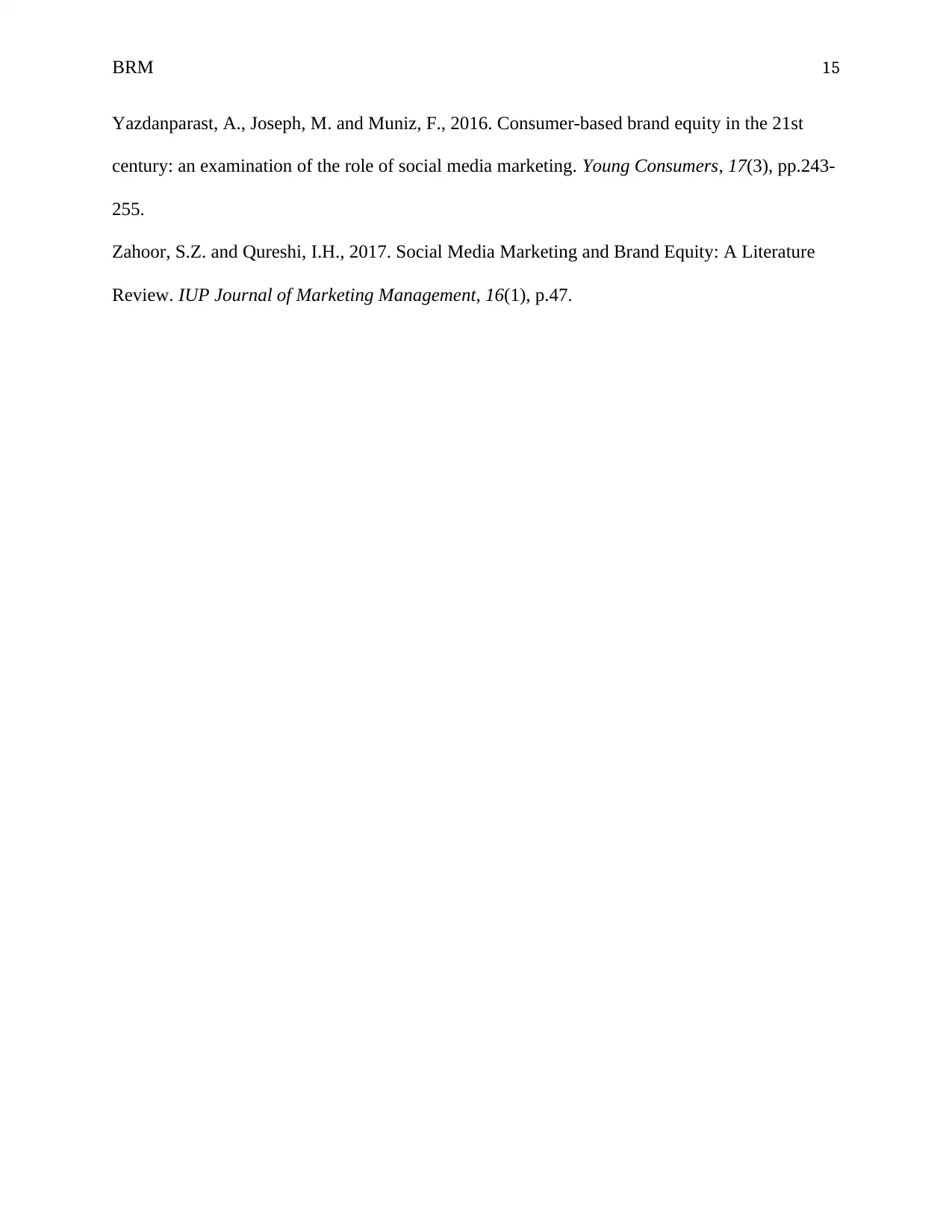
BRM 15
Yazdanparast, A., Joseph, M. and Muniz, F., 2016. Consumer-based brand equity in the 21st
century: an examination of the role of social media marketing. Young Consumers, 17(3), pp.243-
255.
Zahoor, S.Z. and Qureshi, I.H., 2017. Social Media Marketing and Brand Equity: A Literature
Review. IUP Journal of Marketing Management, 16(1), p.47.
Yazdanparast, A., Joseph, M. and Muniz, F., 2016. Consumer-based brand equity in the 21st
century: an examination of the role of social media marketing. Young Consumers, 17(3), pp.243-
255.
Zahoor, S.Z. and Qureshi, I.H., 2017. Social Media Marketing and Brand Equity: A Literature
Review. IUP Journal of Marketing Management, 16(1), p.47.
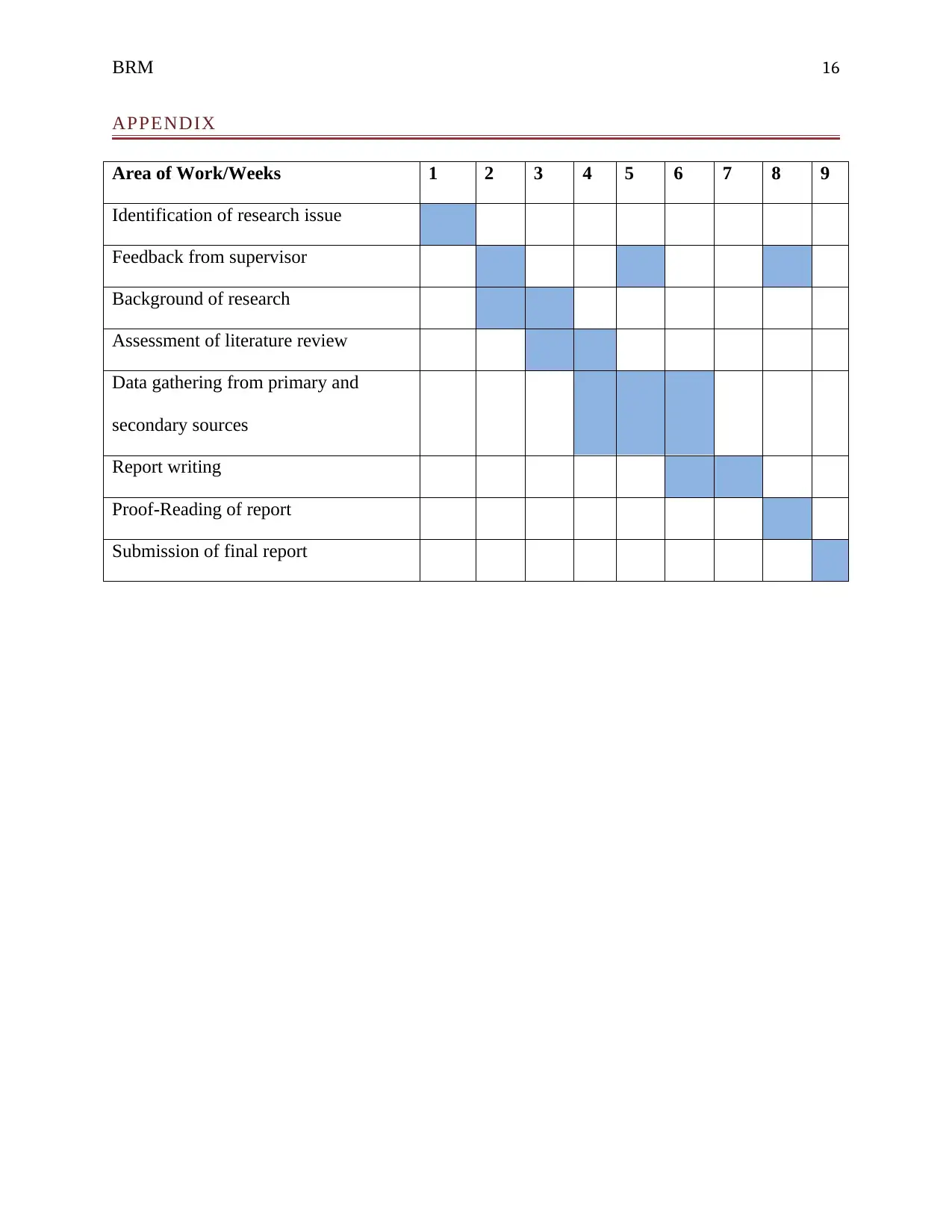
BRM 16
APPENDIX
Area of Work/Weeks 1 2 3 4 5 6 7 8 9
Identification of research issue
Feedback from supervisor
Background of research
Assessment of literature review
Data gathering from primary and
secondary sources
Report writing
Proof-Reading of report
Submission of final report
APPENDIX
Area of Work/Weeks 1 2 3 4 5 6 7 8 9
Identification of research issue
Feedback from supervisor
Background of research
Assessment of literature review
Data gathering from primary and
secondary sources
Report writing
Proof-Reading of report
Submission of final report
1 out of 16
Related Documents
Your All-in-One AI-Powered Toolkit for Academic Success.
+13062052269
info@desklib.com
Available 24*7 on WhatsApp / Email
![[object Object]](/_next/static/media/star-bottom.7253800d.svg)
Unlock your academic potential
© 2024 | Zucol Services PVT LTD | All rights reserved.




